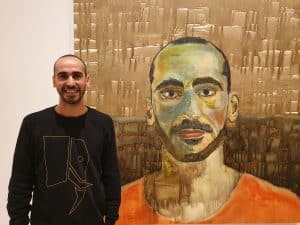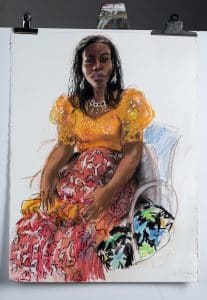Tiny instruments, big hearts with “Sing & Grow”
Tiny instruments, big hearts with “Sing & Grow” Every Thursday morning at the Asylum Seekers Centre in Newtown, our main… Read More
“Art is so powerful. The love and connection and kindness melts away all the anger and hatred.”
It takes a lot to inspire real emotion among every member of an audience of 400 people. But the story of Mostafa ‘Moz’ Azimitabar inspires much, and it inspires many. At the Asylum Seekers Centre’s 30th anniversary celebration at the Seymour Centre, he spoke passionately about the transformative power of art.
From fleeing persecution to being detained by the Australian government for almost eight years, Moz could be forgiven for feeling more than his fair share of anger and hatred. Instead, by turning to art, Moz healed.
“I survived because of art”, Moz said.
He only started painting when he arrived on Manus Island at the age of 28. Confined to a narrow room, treated inhumanely, and denied paint by the guards, he turned to the only materials available to him.
“I looked at the toothbrush and I put it in the coffee. I was not very serious, everyone was laughing at me.”
In 2022, free but still painting exclusively with toothbrushes, Moz was nominated for the Archibald Prize for a self portrait which sought to show the importance and value of refugees in Australia.

Art did more than save Moz. It helped build a connection to his new home and community.
“When I share my story, it doesn’t make me traumatised anymore, ” he said. “I feel more connected with people. There is no fence between you and I anymore. You are my family.”
Renowned portraitist Wendy Sharpe joined Moz on stage to discuss her approach to telling the stories of people seeking asylum through art. She partnered with the Asylum Seekers Centre to create 39 portraits in her ‘Seeking Humanity’ series.

“Sitting with someone for three hours, you can get a sense of how they are at that time. When you spend three hours drawing someone, it’s being with them and it’s embedded in the drawing.”
Sharpe recalls the story of one Afghan man who wore a suit to his portrait sitting. Though he now worked as a taxi driver in Sydney, he had been a successful businessman in Afghanistan, but had to flee from the Taliban to protect his family. “He was wearing a suit and tie because he said ‘this is who I am, and this is who I want to be again’.”
As Sharpe eloquently explained, art is not only a form of survival and transformation, but as a way to connect and humanise those who are so often ignored and othered.
“It is very often the arts that can really touch us. Not just statistically or as facts, but as people and the story behind them.”
The Asylum Seekers Centre coordinates guided tours of the Art Gallery of NSW for members of our community. For more information on our next tour, stay tuned to the ASC What’s On page: https://asylumseekerscentre.org.au/whats-on
Tiny instruments, big hearts with “Sing & Grow” Every Thursday morning at the Asylum Seekers Centre in Newtown, our main… Read More
In the competitive world of catering, Parliament on King combines exceptional cuisine with a powerful social mission. This catering-focused social… Read More
"*" indicates required fields
